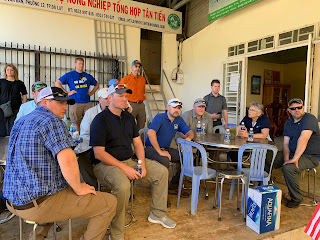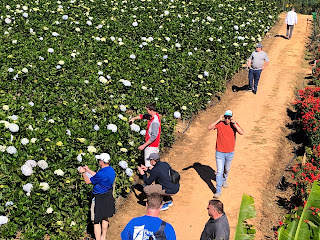Day 8’s adventure began with Class X making their way to the outer edge of Da Lat to tour the Tan Tien Cooperative. Our class’s endurance levels were tested as we ventured nearly three quarters of a mile up and over a steep incline to arrive at a valley of green houses nestled into the hillside.
The farm cooperative itself was formed in 2012 and grows over 50 different types of herb, leaf, and root crops on roughly 6 acres of ground.
The group listens to our guide and had the chance to ask questions.
Products such as lettuce, tomatoes, cabbage, peppers among others were grown using both hydroponics as well as traditional soil production.
Checking out hydroponic Vegetables
Ryan shows Jen and Jessica the best spot to inspect
Matt gets a closer look
Jay finds a red carrot that looks like a beet
Jen and Matt lead the way to a section of the green houses
Careful on the steps Lee!
Jen and Matt lead the way to a section of the green houses
Careful on the steps Lee!
Jackson and Ryan lead the way once down to the next level
Jared and Don examine hydroponic roots
Tanse and Sam both check out the fertilizer / compost:
We were surprised to learn that only 30 employees were required to manage the vast amount of green houses.
A worker weeds the vegetables
Cutting for seeds
Lee inspects an automated vegetable bed planter that the workers were using
A topic many people were interested in dealt with how the cooperative marketed their produce to consumers. Our guide explained that they sell both direct to consumers through local fresh markets as well as into a wholesale markets for distribution to local restaurants and resorts. What truly fascinated us, though, was the fact that they have started to use QR codes on their produce in the local markets to inform consumers where that produce they are purchasing came from. In the US we also continue to see consumers demand transparency in regards to where their food comes from. Many companies are starting to utilize QR codes that, once scanned, can inform an individual the exact place where the food comes from, the practices used in production, and even a little bit of background on the family farm where it was produced. The common thread in both countries of consumer information was a surprise. The cooperative has borrowed methods of hydroponics learned from Israel and also has vegetables that originated from Australia and Europe.
Upon arrival, we were given a brief background on the operation. Starting in the early 1920’s, the French seeded nearly 1,500 acres of tea plants hillsides. The tea factory was established in 1927 with full production beginning in 1931. The tea produced on the farm was exported primarily to Germany, France, and Netherlands. The facility has since branched out into vegetables and flowers.
Scott, Justin and Sam listen to the manager explaining their hydroponics
Cau Dat Farm green house growing operation
The flowers are used mostly for a back drop of people wanting to come and take pictures.
The class views field of flowers:
Our guide took us into what remains of the tea factory and walked us through the process to produce the finished product. The 40 hour process is very intensive and requires that no breaks are taken from the time it is harvested to the time the finished product is placed on the shelf.
The Cau Dat Farm manager explains the initial tea making process to Jared
Tea storage baskets used during first drying
Jessica interprets as the Cau Dat Farm manger explains the mechanized heating & drying of tea
We wrapped up the visit by walking a field of tea plants overlooking the valleys below:
As I reflected on the days visits, it struck me how different, yet similar Vietnamese and US farmers truly are. On one hand we have many Vietnamese farmers still planting and harvesting by hand and farming purely for sustenance and survival. To the contrary, many US farmers utilize today’s newest GPS and variable rate technology and define success on whether their net worth increased or decreased. The thing that bonds them is their love and passion for agriculture. The smile from ear to ear on a farmers face describing the care and love they place into producing crops and animals is synonymous, whether it be US or Vietnamese.
Jackson Waage, Reporter; ReEtta Sieh, Garrett Masat and Tyler Urban, photographers.

























No comments:
Post a Comment